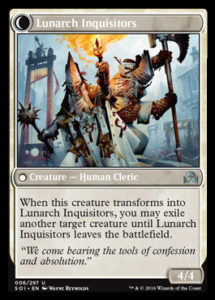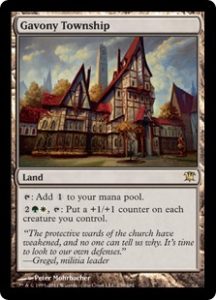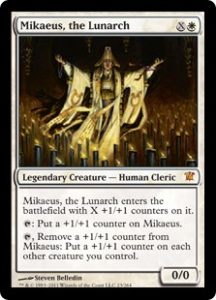Innistrad: a land of dark forests and darker forces. A group of human provinces, protected by stone walls and thatched roofs, stand alone amidst the evils that assail them from within and without. Ghosts, vampires, werewolves and worse stalk the boundaries of civilization or infiltrate its highest ranks to prey upon humankind from within. Only the power of the Church of Avacyn serves to unite the scattered settlements of Innistrad and expel the evils that lurk in their midst.
While our own history lacks the pressing dangers of zombie apocalypse, vampiric infestation, and angelic insurrection, to read about our medieval past is to discover a world not far off from that of Innistrad. Most of the tropes that influenced the genre of Gothic Horror—and with it, Magic’s Gothic Horror plane—drew heavily from medieval folklore, myth, and history to depict the morbid and macabre. In this Planeswalker’s Guide to Earth, we’re going to explore Magic’s returning plane of Innistrad and its cultural and historical inspiration: the medieval Holy Roman Empire.
Germany and the Holy Roman Empire
“The collection that was called and which still calls itself the Holy Roman Empire was neither holy, nor Roman, nor an Empire.” —Voltaire, 1756
Human civilization on Innistrad draws heavily upon the Holy Roman Empire’s Germanic language, culture, faith, and politics as inspiration. The names alone of the creatures of Innistrad—from [casthaven]Kindercatch[/casthaven] to Topplegeist—rely upon German both for their root words and their use of conjunction to combine terms to create a new whole. Meanwhile, the political theocracy embodied in the Church of Avacyn combines the features of Christian monarchy and Papal authority in the Holy Roman Empire for a close allegory on Innistrad.
On a basic level, Innistrad’s human civilization looks a lot like the Empire in the late (1300-1500 CE) medieval period. Thraben, the center of human civilization, is adorned with the intimidating spires and decorative spikes of Gothic architecture, popular in northern Europe as it entered the late middle ages. Gavony Township showcases the sturdy post-and-daub or post-and-beam construction used throughout the Holy Roman Empire, Brittany, the British isles, and even their early colonies in the New World. The fashion of Innistrad humans (and their vampire infiltrators) largely agrees in period, eschewing furs (well, except the werewolves), robes, or rude smocks for doublets, vests, flowing dresses, pants, and neckclothes (which would evolve into the modern tie). Even more strikingly, Innistrad’s humans have nearly-colonial era fixtures like cocked hats (known now as tricorne hats, because the first name is a terrible joke today) and bustles.
The arms and armaments of the Innistrad humans largely echo the late medieval period in northern Europe. A notable feature for its absence is the lack of firearms, which actually drove some of the adaptations expressed in Innistrad armor and military fashion. Mark Rosewater has made clear that Magic generally and Innistrad specifically will not depict guns, which would detract from the sense of fantasy evoked by the game’s lore, but the light armor we see on Innistrad cavalry and the epaulets and buttoned vests on military uniforms express a reality of the late middle ages: heavy armor meant nothing in the age of gunpowder.

Although these Innistrad humans are well-dressed to late medieval standards, the peasants on Unruly Mob suggest that not everyone dresses alike.
The lives and occupations of German citizens of the Holy Roman Empire in this late medieval period also see expression in Innistrad, but with a darker tone and mood appropriate for the many threats faced by the humans of that world. Its vast territory spoke many languages and varied in culture and custom, as do the haughty Thrabens of Innistrad from their seafaring Nephalian cousins.
The Holy Roman Empire began as a collection of feudal Germanic and Gallic fiefdoms, loosely organized into a single “republic” by the energetic Carolignian dynasty which covered territory from eastern France and the Netherlands all the way to Poland and Czechoslovakia in the east and northern Italy and Hungary to the south. The Holy Roman Empire was essentially none of the above—it was a squabbling confederacy of feudal duchies which were more Frankish and Germanic than Roman, and just as prone to brutal inter-Christian territorial struggles as they were to unite in any “holy” cause. What united these disparate peoples, however, in Innistrad and Europe alike, was a shared faith embodied in a powerful and official Church.
Emperors, Popes, and Lunarchs
The first Roman Empire—ruled from the Italian city for which it was named—dissolved in portions from the fourth century to sixth centuries CE. Its legacy, however, long outlived the Italian Caesars themselves, and invited envy from all of Europe which sought to succeed its splendor. Despite losing its military and political power, Rome remained a bastion of culture and artistic achievement which much of Europe sought to inherit, and it still possessed the de facto center of western Christian faith in the bishopric of Rome. These factors combined in the year 800, when Pope Leo III crowned the German monarch Charlemagne “Emperor of the Romans,” uniting the spiritual authority of the Church with the rising temporal power of the Germanic state.
For centuries to follow, the Holy Roman Empire (ostensibly) served as the military and political arm of the spiritual Christian church, working to convert non-Christian subjects and expand Christian rule through the wilderness (although it would be later “Holy Roman Emperors” who would sack Rome and appoint their own Popes to subvert the authority of the Catholic Church).
The Church of Avacyn largely does away with the political realm of Emperors and rules Innistrad’s human population through the religious office of the Lunarch (and, after Mikaeus’ death and terrible resurrection, the Lunar Council). Located in the central city of Thraben, the Church of Avacyn represents the *theoretical* synthesis of temporal power and spiritual authority embodied by the Holy Roman Empire during the medieval period. Although Pope and Emperor were never combined on Earth – and were more frequently than not rivals in the expanse of medieval history – the dream of the Empire was a theocracy like Innistrad’s Church of Avacyn, where the rule of the state could enforce the will of God. “The ideal,” writes historian A.L. Smith, “was to make a working reality of the kingdom of God on earth; to express the laws of that kingdom in a coherent, all-embracing code, and to enforce that code upon the still half-heathen kingdoms of this world.” Whatever their differences, on Innistrad and Earth alike, the comparable religious and political authorities could unite in one cause: the expansion of their faith and state, sometimes across an impenetrable wilderness hostile to this incursion.
The Black Forest
“For centuries, the Church [in Germany] waged intense war with werewolves and wild women, fairies and witches, norns and goblins.” —Lindahl, Lindell, McNamara, Encyclopedia of Medieval Folklore
Innistrad and the Holy Roman Empire possess a tremendous common feature in their shared landscape: a world of isolated villages amidst a great sea of trees. At its height the historical Empire largely ruled a impenetrably dense woodland across modern Germany and Eastern Europe known at its southernmost region as “The Black Forest,” from which lumber, amber, and furs were extracted and in which dark forces were believed to lie in wait to ensnare the unwary.
The union of Church and state in Germany was not without reason. The Holy Roman Empire was founded and consolidated in a period of turmoil, with recent pagan (Saxon 777 CE, Avars 788 CE, Viking 790 onwards, Danes 808) and Muslim (711 CE, 721 CE onwards) invasions shaping a sense of Christianity under assault by exterior forces. Meanwhile, even those who had converted to the Christian faith in these once-pagan lands were prone to secret worship of the old gods even in the midst of God-fearing society. Pagan Saxons and others under Charlemagne’s rule held to their traditions even as the Pope blessed their Emperor’s conquests, and would rise in rebellion when Christian authority became cruel in its efforts to uproot dissension.

Another somewhat modern element of Innistrad: the guillotine in back. Intended as a humane and surgical instrument of execution, it largely arrived on the scene after the Inquisition was putting people to the stake. It makes sense, however, not to rely on the images of nooses used in Tree of Redemption.
The Holy Roman Empire believed itself beset from within and without, and nearly always was at war against non-Christian forces. Even when Columbus sailed the ocean blue in 1492, the aging German state was still engaged in the holy cause of conquest and conversion: neighboring Lithuania to the northeast still held to pagan worship on the very borders of the Holy Roman Empire. Despite the zeal and ambitions of Christian authority, the old gods of Europe’s great forests would survive into the modern era of the New World.
The very landscape of the forest magnified these fears. Bishops in Germany complained of bandits and pagan cultists beyond the fane of the Church and civilization who hid in the impenetrable wilderness, while peasants and townfolk told stories of creatures that lurked in the dark woods beyond their village fields. It is from the Holy Roman Empire—or the territories along its forested borders—that the Gothic legends of Innistrad were born. Come back next week, where we’ll talk about werewolves, ghosts, and the lurking menace of vampires.
Curtis always invites you to leave a comment! But sometimes he doesn’t get a notification and misses them, so he’ll check back.



